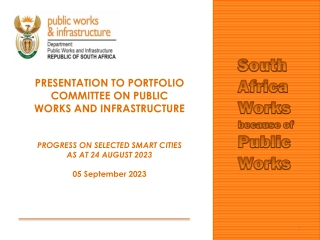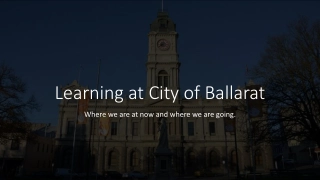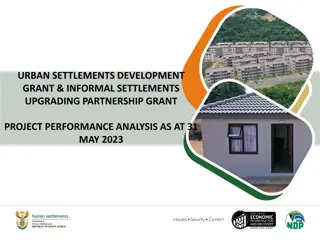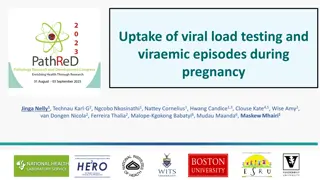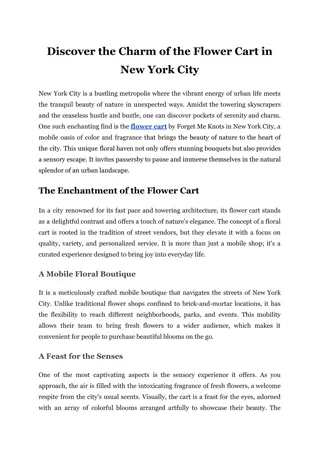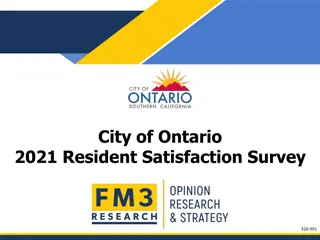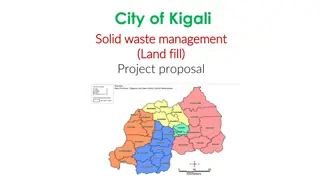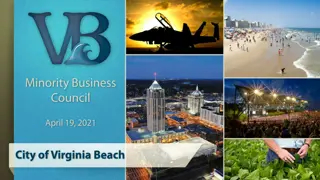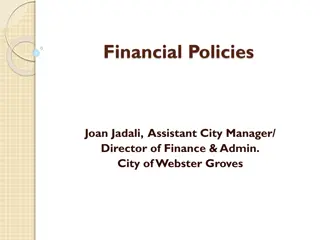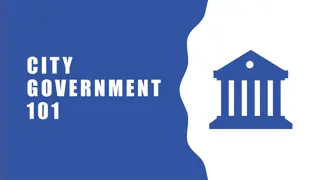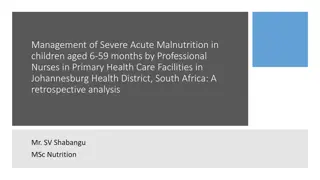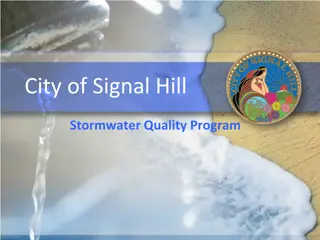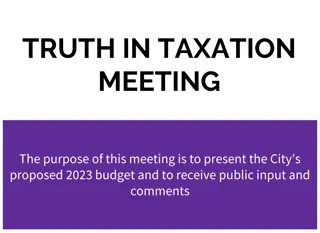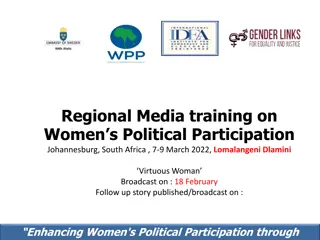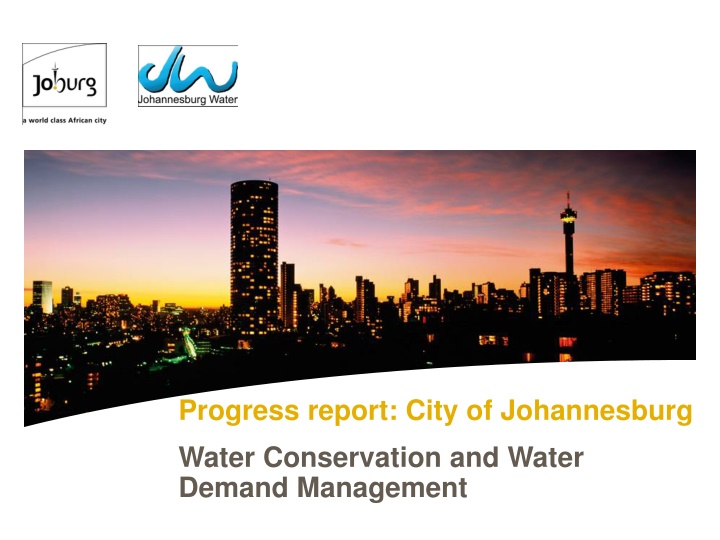
Water Conservation and Demand Management in City of Johannesburg
Enhancing water conservation and demand management in Johannesburg through strategic interventions like educational campaigns, infrastructure upgrades, and active leakage control. Efforts focus on reducing non-revenue water and meeting water demand projections, with a priority on achieving maximum benefits within budget constraints.
Download Presentation

Please find below an Image/Link to download the presentation.
The content on the website is provided AS IS for your information and personal use only. It may not be sold, licensed, or shared on other websites without obtaining consent from the author. If you encounter any issues during the download, it is possible that the publisher has removed the file from their server.
You are allowed to download the files provided on this website for personal or commercial use, subject to the condition that they are used lawfully. All files are the property of their respective owners.
The content on the website is provided AS IS for your information and personal use only. It may not be sold, licensed, or shared on other websites without obtaining consent from the author.
E N D
Presentation Transcript
Progress report: City of Johannesburg Water Conservation and Water Demand Management
Status Quo Non Revenue Water Water Balance 600.00 48.0% 39.7% Water Consumption (million 38.2% 37.9% 37.9% % Non-revenue Water 35.6% 34.9% 500.00 40.0% 33.6% 33.1% 400.00 32.0% m3/annum) 300.00 24.0% 200.00 16.0% 100.00 8.0% 0.00 0.0% Billed Metered Billed Un-metered Non-revenue water (NRW) % Non-revenue water 2
Target = 45.39 million m3/annum Water Demand Projections 620.0 Water Demand (million m3/annum) 570.0 520.0 470.0 420.0 5 Years & Efficiency 5 Years WDM Actual Demand High population No WDM 2009 3
Summary of Interventions Priority is given to WC/WDM interventions that will achieve maximum benefits, also taking to account the limited budget available for WC/WDM: Educational and awareness campaigns Soweto Infrastructure Upgrade Pressure Management Active Leakage Control Water Mains Replacement 4
Education and Awareness Campaigns Billlboard advertising at major traffic intersections Water Warriors Campus tours Radio campaigns/ Twitter/ Facebook Water saving tips, Report leaks and illegal connections Taxi advertising 40 Tappie school visits 134 Ward meetings and workshops 5
Soweto Infrastructure Upgrade Infrastructure upgrade secondary mains Decommissioning mid-blocks Repair on-property leaks Installation of pre-payment meters Re-establishment of water zones Re-visiting properties in previously intervened areas Normalising meter by-passes Meter upgrades to include AMR function 6
Soweto Infrastructure Upgrade Commenced Suspended Resumed Soweto Selected Bulk Supply Monthly Consumptions 1.00E+07 9.50E+06 9.00E+06 8.50E+06 Over 40,000 meter by-pass and illegal connections 8.00E+06 Intervention areas 7.50E+06 7.00E+06 6.50E+06 134 Public meetings, door to door campaigns, workshops, 78 531 pre- intervention surveys with metering 6.00E+06 Volume ( kl ) 5.50E+06 5.00E+06 4.50E+06 4.00E+06 54m3hh/month savings: 98,800meters, 116km mains replaced, 52 zones established 3.50E+06 3.00E+06 2.50E+06 2.00E+06 1.50E+06 1.00E+06 5.00E+05 0.00E+00 Jul/02 Jul/01 Jul/03 Jul/04 Jul/05 Jul/06 Jul/07 Jul/08 Jul/09 Jul/10 Jul/11 Jul/12 Apr/09 Apr/01 Oct/01 Apr/02 Oct/02 Apr/03 Oct/03 Apr/04 Oct/04 Apr/05 Oct/05 Apr/06 Oct/06 Apr/07 Oct/07 Apr/08 Oct/08 Oct/09 Apr/10 Oct/10 Apr/11 Oct/11 Apr/12 Jan/05 Jan/11 Jan/01 Jan/02 Jan/03 Jan/04 Jan/06 Jan/07 Jan/08 Jan/09 Jan/10 Jan/12 Month Graph by C. Botha (JW) 7
Pressure Management Procurement process for the Servicing and repair of 500 PRV s to ensure complete functionality of all installations. The scope will include re-establishment of pressure zones and installation/repair of zone meters where required. Installation of 15 new PRV s in areas with static pressure >90m. Project should commence in January 2013 Anticipated savings of 35 million m3/annum Completing PRV maintenance training courses for staff 8
Pressure Management Case study: Oakdene Oakdene is fed directly from the 250mm Rand Water supply feeding Forest Hill Reservoir. The supply is metered by a 200mm diameter Meinecke WP type meter There was previously no PRV fitted. Delivery pressure into the zone was approximately 16 bars. The Oakdene zone suffered with average 5 bursts a week. Due to the high pressures there were numerous leaking meters, valves as well as fire hydrants. Oakdene s problem is that many of the bursts don t surface where they occur, due to the rocky terrain making location of leaks difficult and increase time taken to locate the bursts. 9
Installation total cost R60,000 10
Results: 79m3/hr savings at night time @ R5.15/m3 R891,000/yr Below is a comparison of before and after installation: CRITICAL POINT MIN 8.3 BARS 5.1 BARS 3.2BARS MAX 11.3 BARS 7.4 BARS 3.9BARS AVE BEFORE AFTER REDUCTION 10.3 BARS 6.8 BARS 3.5BAR LOWEST POINT MIN MAX 16.3 BARS 14 BARS 2.3BARS AVE BEFORE AFTER REDUCTION 15.8 BARS 12.1 BARS 3.7BARS 15.7 BARS 13.3 BARS 2.4BARS FLOW MIN 176m /h 75m /h 10.1m /h MAX 272m /h 197m /h 75m /h AVE 218m /h 139m /h 79m /h BEFORE AFTER REDUCTION 13
Leakage Management Passive AVERAGE MONTHLY WATER BURSTS 4,000 3,500 NUMBER 3,000 2,500 2,000 2011/2012 1,500 AVERAGE PER YEAR 1,000 Linear (AVERAGE PER YEAR) 500 0 July Aug Sept Oct Nov Dec Jan Feb March April May June 2011/2012 AVERAGE PER YEAR 3,627 3,300 3,460 3,214 3,301 2,894 2,776 2,988 2,813 2,937 2,104 2,514 2,734 2,963 2,894 2,982 3,265 3,244 2,487 2,747 3,239 3,402 3,165 3,750 MONTHS 14
Leakage Management Active Active Leakage Control YTD 12/13 (July-Sept 2012) 415 1668 105 91 2172.11 Burst pipes detected Leaking meter detected Leaking valve detected Leaking hydrant detected Length of main surveyed (km) 97 DMA s covered and discreetness verified 15
Water Mains Replacement Replacement and upgrade (2009/10 to 2011/12) = 331.27km 15 suburbs covering 35km have been identified for Mains Replacement in the 12/13FY with the RUL<2yrs. The projects are at design and tendering phases. 16
Water Mains Replacement Location Total Length (m) Pipe Length to be replaced (m) Estimated Construction Cost (R ) 2,500,000 % with RUL < 2 Winchester Hills 2,500 2,500 100% Bryanston 18 Benmore Gardens Bramley North Ext 245 245 245,000 100% 5,315 955 955,000 18% 1,587 325 325,000 20% Bramley Ext 1 Bramley Park North 1,085 60 60,000 6% 3,502 1,745 1,745,000 50% Glen Atholl 770 770 770,000 100% Glenadriene 3,739 3,500 3,500,000 94% Hurlingham Ext 1 Kentview 180 180 180,000 100% 225 160 160,000 71% Kramerville 1,870 675 675,000 36% Morningside Ext 26 Morningside Ext 49 Morningside Manor Northcliff Ext 3 276 230 230,000 83% 260 260 260,000 100% 8,875 7,520 7,520,000 85% 2,455 810 810,000 88% 65% TOTAL 32,884 21,295 19,975,640 17
Financial Implications and anticipated savings 12/13 13/14 Projected savings Ml/annum Projected savings Ml/annum Intervention/ Programme Education and awareness campaigns Soweto Infrastructure Upgrade and Renewal Approved budget (R) Required budget (R) Total savings R/annum Source of funding *Indirect measurable 9,000 *Indirect measurable 34,226 OPEX 11,600,000 82,500,000 CAPEX 153,000,000 340,834,000 196,678,300 173,209,400 35,843 0 OPEX 10,000,000 2,000,000 Pressure Management 2,225 10,300 0 CAPEX 11,500,000 0 94,640,000 10,500 Active leakage control OPEX 64,200,000 64,200,000 Mains Replacement CAPEX 20,000,000 R270,300,000 123 57,491 43,860,000 533,394, 000 288 45,014 1,870,050 466,397,750 Totals 18
RISK ASSESSMENT The organisation has at least 24 months to implement the accelerated strategy in order to meet the aforementioned national targets by the 2014/15 financial year. Inadequate funding for the strategy has been identified as the biggest risk in achieving the desired outcomes, this risk has the highest rating within the organisation and as such it is being managed at a corporate level. 19
Conclusion Pressure management and fixing on-property leaks activities are identified and targeted as a cost-effective demand management intervention that can yield significant reductions in demand. Efforts to reduce deemed areas in Johannesburg should be priority incase water restrictions are enforced. All programmes should be linked with an education campaign and maintenance plan to ensure sustainability. . 20

